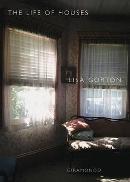LISA GORTON The Life of Houses. Reviewed by Lou Murphy
 The cyclical nature of life, intergenerational distance and the elasticity of time are all captured beautifully in this novel.
The cyclical nature of life, intergenerational distance and the elasticity of time are all captured beautifully in this novel.
A literary exercise in artistic foreshortening, The Life of Houses traverses distortions of perspective in time and place,
meandering through a nostalgic menagerie of past relationships and the subjective mysteries of the present.
The story oscillates between the narratives of Anna and her teenage daughter, Kit. Recently separated from her husband (Kit’s father, Matt), Anna grieves for her lost relationship with her ex, while negotiating the often uncomfortable terrain of her unfolding relationship with Peter, a man she has been having an affair with. Estranged for years from her parents and sister, Anna nonetheless sends Kit to spend the week with them, ostensibly so she can pursue the next step in her relationship with Peter in Kit’s absence. The cyclical nature of life, the intergenerational distance between a middle-aged woman and her teenage daughter, is captured beautifully by Anna, as she contemplates the elastic nature of time:
… Kit is there now, in the room where at night the sea comes up to the window. She has gone back to where I was. Children have hours that lead nowhere. They have hours and hours. I used to spend my whole afternoons on that bed, bored beyond anything. Now all my hours are small: they have afterwards always. When I am bored, it is small boredom; back then it was touching time itself …
Kit’s story focuses on her arrival at the seaside town on the south-east coast of Australia where her mother’s family home is situated. Coming from a privileged urban existence to stay with the relatives she doesn’t know well at their decaying house is at once confronting and mysterious. She moves through the rooms of her mother’s childhood with lonely disassociation. As she gets to know more of the inhabitants of the town they form a pastiche of vivid, subjective portraits; of the grandparents, the aunt, and the artist friend from her mother’s youth. Relatives and other people from her mother’s past are detailed with earnest dissections of their features, skewered by varying depths of perspective. The town itself takes on the disorientating dimensions of a set:
… She was outside a jewellery store. Its glass diamonds and gold-plated chains, set out on dusty purple velvet, added to her sense of the town as a stage set. The wind had more reality than these narrow, bright shopfronts, huddled under awnings. Their deliberate quaintness emphasised the street’s exposure and vacancy – the sea opening out where the other side of the hill should have been.
The atmospheric influence of habitat upon psyche is explored further in the contrast between private and public space, the personal and impersonal relationship of subject and place. Inoculated from modernity by its unchanged furniture and décor, the family home is a place where time has stood still, playing host to a resident ghost. Knowing that she will one day inherit the house, Kit grapples with the notion of possession – what it means to own something; and how ownership is an extension of the self. Meanwhile, her mother tackles similar issues when Peter visits, unsettling her sense of the house and her connection to the objects within it. Gorton captures well how impossible it is for an individual to get a real handle, ever, on the reality of a moment. So what we are left with, instead, is a mirage of places changed and unchanged, constantly in flux:
Her body was not hers any more than that bedside table, the clock radio with its shining red rectangular numbers. In the car she had felt that she could just keep driving, north up the coast. She thought: tomorrow night someone else will sleep here. Motel rooms have no ghosts. Every morning cleaners come in to empty the bins.
When family tragedy pushes the plot to a merging of Anna’s present life with that of her past, and with her daughter’s, the exigencies of motherhood and family are thrown into stark relief. Sensorially a discord is revealed between knowledge accumulated through socially subconscious learning and the emotional realities of impermanence and mortality; realities that inform the ensuing decisions that Anna and Kit are confronted with.
Lisa Gorton The Life of Houses Giramondo Publishing 2015 PB 232pp $26.95
Lou Murphy is the author of the crime novel Squealer, available from http://www.smashwords.com/profile/view/LouMurphy
You can buy this book from Abbey’s at a 10% discount by quoting the promotion code NEWTOWNREVIEW here or you can buy it from Booktopia here.
To see if it is available from Newtown Library, click here.







